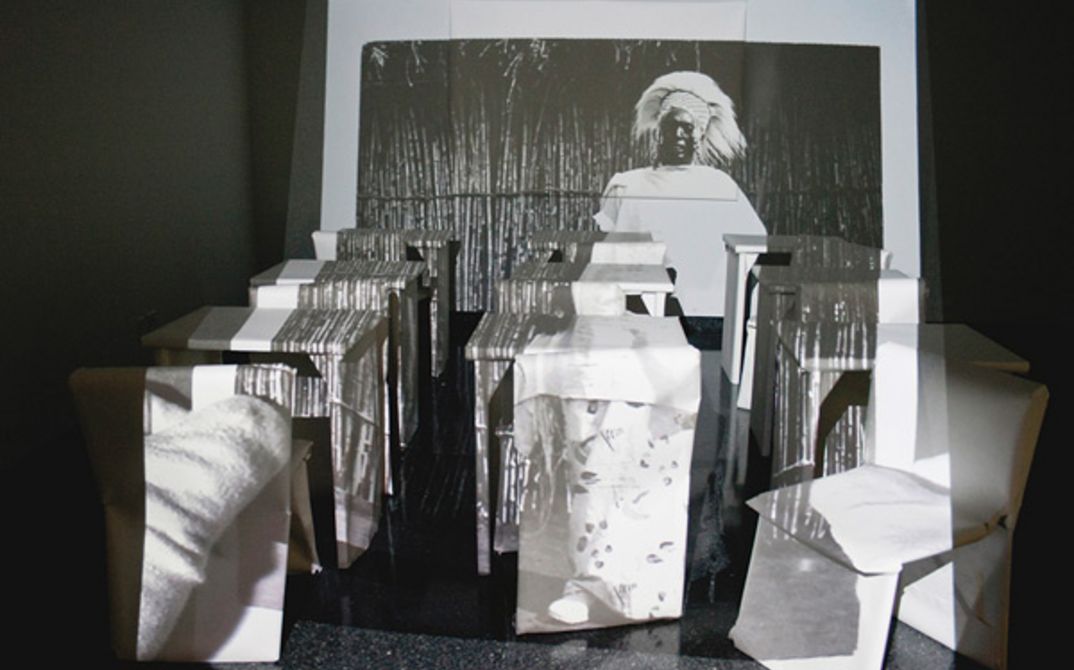Download Catalogue (PDF)
Instructions for TAUT
TAUT utilizes some of the extraordinary Black Star Collection (archived at the Ryerson Image Centre in Toronto) of news photographs (demonstrations, rallies, riots, confrontations, etc.). A video of the artist’s hands holding such photographs are projected onto a real classroom (chairs, tables, and a chalkboard) which will be covered in white paper to become a three dimensional white screen for the two-dimensional images of three-dimensional events and places. It’s a three-dimensional work and each position of the viewer/spectator will be rewarded with different “effects” relative to the projections on areas of wrapped tables and chairs. There is no one “best” point of view as each superimposed photographic projection makes different light and shade things happen. It’s a three-dimensional sculptural work, not a movie. The placement of the chairs and tables and chalkboard should allow the spectators to stand mostly to the right of the tables and chairs but also from behind them and from the left side (at Ryerson, this was the smallest space). The tables, chairs and chalkboard should be wrapped with matte white paper (a warm white is preferred) and taped with matte white adhesive tape. The paper should be as unwrinkled as possible, and the tape should be as similar to the paper as possible. The seams of the paper should face away from the projection. In order to make a vertical projected image, the projector used is mounted on its side. At its first installation at the Ryerson Image Centre, the projector was mounted about 7 feet from the floor aimed at the wrapped furniture and the chalkboard. This meant that people’s heads passed through the projection beam as they moved around the installation. In order to make a vertical projected image, the projector used is mounted on its side. The Ryerson installation should be used as a model, but because of the size of the given room, and the size of the tables and chairs, it might be that to fill the same scale of space, more or fewer tables and chairs may need to be used. At the Ryerson installation, there were 9 tables and chairs. The room that housed TAUT was 23 feet and 9 inches (7.24 metres) by 17 feet and 9.5 inches (5.25 metres) with a ceiling height of 8 feet and 6 inches (2.59 metres). It is important to maintain the amount of walk around space that the Ryerson installation used.
Michael Snow, born in 1928 in Toronto, works in many media: film, video and sound installation, photography, holography, music, bookworks, sculpture, painting, and drawing. His visual artworks are widely collected and exhibited, including solo exhibitions at the Art Gallery of Ontario and the Power Plant (Toronto), National
Gallery of Canada (Ottawa), Hara Museum (Tokyo), Museum of Modern Art (New York), Centre Pompidou (Paris), and at the Secession (Vienna). Snow’s films and video have been shown extensively in festivals (London, New York, Rotterdam, and Berlin) and are in the collections of the Oesterreichisches Filmmuseum (Vienna), Anthology Film Archives (New York) and Royal Belgian Film Archive (Brussels). A long-time professional musician, Snow has performed in Canada, the US, Europe, and Japan – most often with Toronto-based CCMC – and has released many recordings. His interactive DVD-ROM “Anarchive 2-Digital Snow” (2002) is online at www.fondation-langlois.org/digital-snow
Contact: www.ryerson.ca/ric
Format: Single-channel video installation, silent, photographic paper, furniture
With the kind support of Ryerson Image Centre, Toronto, Canada

Michael Snow
Taut
Canada 2012